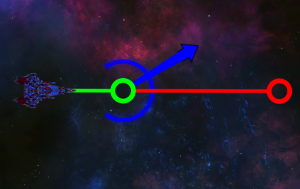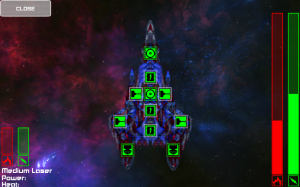I believe I’ve mentioned it before, that when people sit down to play Flame Warrior the thing they seem to struggle most with is figuring out how to get their ship to move where they want it to go. Which drove home the need for an effective tutorial, so that’s what I’ve been working on for the past while. It was a surprisingly large amount of work, it required a lot of scripting framework and support stuff. Just getting it to show dialog and instructions wasn’t too bad. Having it detect different checkpoints for the player where additional tutorial information was required was a bit more complicated but again, not too bad. What really consumed a lot of time was the little touches that I thought made a big difference. This is what the ship movement interface looks like:
 It’s kind of complicated looking, but it’s just about as simple as I’ve been able to make it. I used to display an image like that with a wall of text explaining what everything did, and it understandably confused people. Then there was the whole ship systems screen:
It’s kind of complicated looking, but it’s just about as simple as I’ve been able to make it. I used to display an image like that with a wall of text explaining what everything did, and it understandably confused people. Then there was the whole ship systems screen:
 Which again is somewhat intimidating and confusing. So, in the past I would sit someone down, and lean over their shoulder and try to explain everything, and it was understandably overwhelming.
Which again is somewhat intimidating and confusing. So, in the past I would sit someone down, and lean over their shoulder and try to explain everything, and it was understandably overwhelming.
So I made the first level about nothing but movement, no combat at all, so the player never has to visit the ship systems screen. Then I broke up the movement interface. The first turn all the player sees is the green line and the green circle, indicating the path that their ship will take. As the level goes on more and more of the interface is introduced. But of course that required a lot of special case programming to disable the different parts, and re enable them with scripting, and so forth.
One thing that was a big pain, but I’m so glad I did, was to make it so that the tutorial prompts expect, and respond to the player interacting with the interface. So rather than having several dialog boxes pop up while the NPC infodumps on the character explaining all the steps, and requiring the player to remember every step and faithfully execute them. Instead it allows and requires you to perform each action before it goes on to the next. This is a hallmark of good tutorials everywhere, but it was still a bit of a pain to implement, but it was very worth it. I noticed that it was how everyone naturally expected it to behave.
Aside from vetting the tutorial, it was also a great opportunity to see how people react to the game overall. And it was very well received, most of the people who played it enjoyed it quite a bit. Now, for some exciting news, I’m going to be doing a couple of adjustments to things that I noticed last night, and then I’m going to get a copy of the tutorial up on the site for people to play. So if you’ve been following the development, but haven’t had a chance to play it yet, you soon will.
